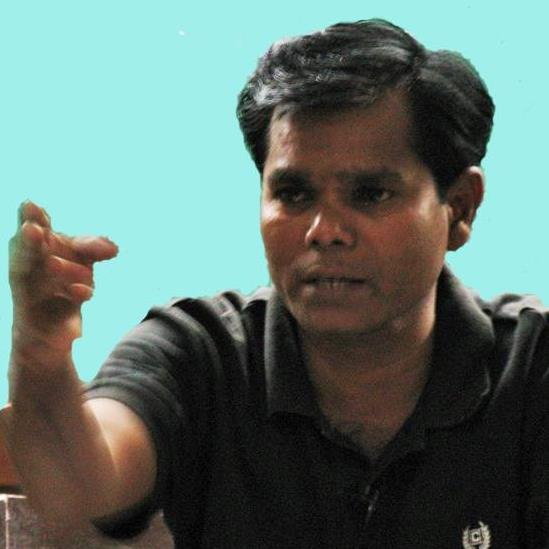Rajesh Rajamani
 Recently, when ‘Kabali’ director Pa Ranjith introduced ‘The Casteless Collective’, an initiative that attempts to politicize and mainstream ‘Gaana’ music (considered to be a musical form of the oppressed), he was accused of bringing caste into art. Popular Tamil singer Srinivas from the Iyengar community rubbished the initiative on his social media account and termed it ‘pseudo’ and ‘pointless’. He wanted Pa Ranjith to talk about caste elsewhere and not bring it to music. News 7, a Tamil news channel went on to carry a debate titled “Is Pa Ranjith forcing caste into art?” On the other hand, when another Iyengar TM Krishna initiated the Uroor-Olcott Kuppam Marghazi Vizha in 2015, an effort that took Carnatic music to a fisher-folk village, he was hailed across various quarters for making music transcend caste barriers. (Because, why not?)
Recently, when ‘Kabali’ director Pa Ranjith introduced ‘The Casteless Collective’, an initiative that attempts to politicize and mainstream ‘Gaana’ music (considered to be a musical form of the oppressed), he was accused of bringing caste into art. Popular Tamil singer Srinivas from the Iyengar community rubbished the initiative on his social media account and termed it ‘pseudo’ and ‘pointless’. He wanted Pa Ranjith to talk about caste elsewhere and not bring it to music. News 7, a Tamil news channel went on to carry a debate titled “Is Pa Ranjith forcing caste into art?” On the other hand, when another Iyengar TM Krishna initiated the Uroor-Olcott Kuppam Marghazi Vizha in 2015, an effort that took Carnatic music to a fisher-folk village, he was hailed across various quarters for making music transcend caste barriers. (Because, why not?)
Unsurprisingly, caste seems to work this way. Even the privilege to remain casteless is only made available to Savarnas. Which is why in spite of all the half-baked things that TM Krishna says, writes and does, he is going to be thrust on us as a revolutionary. Whenever one remarks something critical about TM Krishna’s ‘radical’ initiatives, it is always met with responses that claim “But hey, he is at least doing something. So we can’t completely reject him!” or the even more boring, “Do you know how many Brahmins hate him for the radical things he is doing?” (A big yawn.)
There is a glaring irony in any Brahmin trying to become an anti-caste revolutionary. If TM Krishna or any other Brahmin has to be regarded as an anti-caste revolutionary, then their contribution should weaken the caste structure, in at least the domain they are working. Which means that the Brahmin-Savarnas who have accumulated privileges over centuries should lose some of it. And those who never had any privileges, gain some. This must be achieved through a structural change and not through any philanthropic activity. Just a bare minimal requirement, right? So going by this basic principle, I am sure we can agree that the Brahmin revolutionary too (being part of the caste structure) should lose some of his/her privileges in the process. (Yes only, no?)
But what has TM Krishna’s supposedly ‘radical’ initiatives led to?
1. He wins the Magsaysay award. The same year, Bezwada Wilson too wins the award. Wilson has been fighting to end manual scavenging for over 30 years. On the other hand, TM Krishna lived most of his life as a very privileged Iyengar. And suddenly discovered ‘Caste’ on one lazy summer morning. ‘The Hindu’ when publishing the news about the Magsaysay award winners allots a huge chunk of the first page to Krishna and a small box news for Wilson.This directly reveals how the caste structure works. TM Krishna’s pointless, patronizing but well-publicized events allowed him to reap a huge benefit here. But Wilson’s 30 plus years of work put him behind the new Iyenger kid on the block. (Obviously!)

2. TM Krishna quits the December music season citing reasons, which include the domination of the Carnatic music scene by a single community. Ahem! The same community he belongs to, that is. As someone who has drawn all possible benefits out of the season by being part of the community, he decides to quit it one day. Did it make him lose his privileges? Not one bit. In fact, he has already sucked all the privileges out of the December music season and become some sort of a star singer. By quitting the season, he actually becomes an even more sought after singer. And basic economics tells us that when you lower the supply, the demand automatically goes up. Which in this case would naturally translate to an increase in ticket prices for his concerts. By making the decision to quit the season, he has become a bigger star, who is commercially better off. He is no more one among the several singers of the crowded season. But someone you can only access exclusively. (Smart move, right?)
3. Every now and then, TM Krishna works with lower caste singers, musicians or art forms. And if you cared to notice (am sure, you have), we hardly get to see any of their names or faces. The only name that is repeatedly pushed down our throat is TM Krishna’s. All his generosity in willing to work with art forms or artists from oppressed communities has not done anything significant to them. And it can’t too. But on the other hand, it has made him some sort of a benevolent and revolutionary cultural icon. Which further increases his market value as a Carnatic singer. In the crowded Carnatic market scene, TM Krishna has been able to stand out by stepping on the shoulders of these nameless, faceless artists. It was alleged that there was a tough competition for the top spot between TM Krishna and another Carnatic singer Sanjay Subrahmanyan, an Iyer – leading to some sort of an intra-agraharam tussle. But with the kind of posturing Krishna has been doing the last few years, he has been able to easily overshadow Sanjay Subrahmanyam. (Is Iyengar the new ‘higher’?)
4. There is a direct commercial value in artists indulging in socially woke activities. When actor Salman Khan drunk drove and killed people sleeping on the pavement, he was advised to start the ‘Being Human’ brand. Tamil actor Surya and his family members make emotional appeals about their Agaram Foundation. Another Tamil actor Kamal Hassan peddled atheism and Periyar to appeal to the Dravidian audience when his competitor Rajinikant was doing better with the masses. Actor Aamir Khan confirmed his progressiveness by repeatedly sobbing on his show Satyamev Jayate. The thing is, in highly competitive environments, artists can never become huge stars by just minding their own business. They have to create goodwill karma and build a cult around it. And the return on investment in such activities is freakingly huge and translates to better business. We don’t know and will never know if anyone really got benefitted through the ‘Being Human’ initiative. But it has made Salman a bigger brand than he already was. Similarly, TM Krishna has only become a bigger brand through all his philanthropic initiatives.(Whatte wow!)
So where were we? Yeah. We kind of agreed that if TM Krishna’s radical initiatives are worthwhile, then it should leave him with fewer privileges than where he started. But is that what is happening? Not at all. He is rather becoming a bigger star and only accumulating more and more privileges. And by amassing these privileges, will he be strengthening the caste system or weakening it? (Tell me, please!)
By wallowing in a series of photo-op friendly initiatives, TM Krishna is only robbing the voice of several Dalit-Bahujan activists who have been working in the anti-caste space for decades but will never be heard. In a caste society, for any real revolution to happen, the Brahmin should learn to shut up. Or in TM Krishna’s case, he can also use the ancestral property (polite term for caste property) he has inherited to create a new Music Sabha and ban Brahmins from it. Doing anything else is just the equivalent of loud farting. And we all might have to just close our noses for a while.
~~~
Rajesh Rajamani wonders if readers believe everything that an ‘author’s bio’ claims. He also writes a web-comic series called ‘Inedible India’. He is currently based out of Bangalore.










